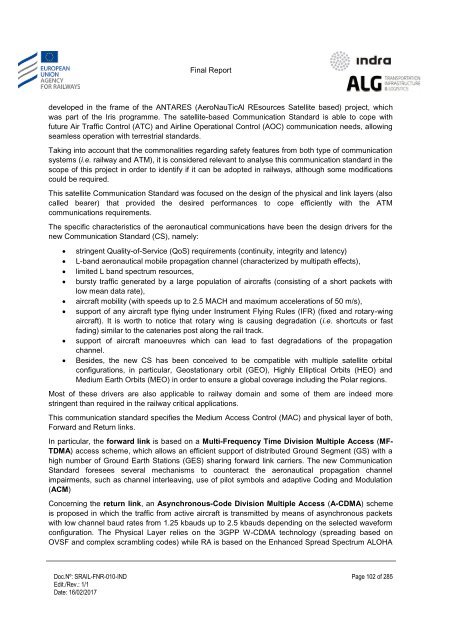Study on feasibility of SATCOM for railway communication
SRAIL-FNR-010-IND%20-%20FinalReport_v1.1_20170216
SRAIL-FNR-010-IND%20-%20FinalReport_v1.1_20170216
Create successful ePaper yourself
Turn your PDF publications into a flip-book with our unique Google optimized e-Paper software.
Final Report<br />
developed in the frame <strong>of</strong> the ANTARES (AeroNauTicAl REsources Satellite based) project, which<br />
was part <strong>of</strong> the Iris programme. The satellite-based Communicati<strong>on</strong> Standard is able to cope with<br />
future Air Traffic C<strong>on</strong>trol (ATC) and Airline Operati<strong>on</strong>al C<strong>on</strong>trol (AOC) communicati<strong>on</strong> needs, allowing<br />
seamless operati<strong>on</strong> with terrestrial standards.<br />
Taking into account that the comm<strong>on</strong>alities regarding safety features from both type <strong>of</strong> communicati<strong>on</strong><br />
systems (i.e. <strong>railway</strong> and ATM), it is c<strong>on</strong>sidered relevant to analyse this communicati<strong>on</strong> standard in the<br />
scope <strong>of</strong> this project in order to identify if it can be adopted in <strong>railway</strong>s, although some modificati<strong>on</strong>s<br />
could be required.<br />
This satellite Communicati<strong>on</strong> Standard was focused <strong>on</strong> the design <strong>of</strong> the physical and link layers (also<br />
called bearer) that provided the desired per<strong>for</strong>mances to cope efficiently with the ATM<br />
communicati<strong>on</strong>s requirements.<br />
The specific characteristics <strong>of</strong> the aer<strong>on</strong>autical communicati<strong>on</strong>s have been the design drivers <strong>for</strong> the<br />
new Communicati<strong>on</strong> Standard (CS), namely:<br />
<br />
<br />
<br />
<br />
<br />
<br />
<br />
<br />
stringent Quality-<strong>of</strong>-Service (QoS) requirements (c<strong>on</strong>tinuity, integrity and latency)<br />
L-band aer<strong>on</strong>autical mobile propagati<strong>on</strong> channel (characterized by multipath effects),<br />
limited L band spectrum resources,<br />
bursty traffic generated by a large populati<strong>on</strong> <strong>of</strong> aircrafts (c<strong>on</strong>sisting <strong>of</strong> a short packets with<br />
low mean data rate),<br />
aircraft mobility (with speeds up to 2.5 MACH and maximum accelerati<strong>on</strong>s <strong>of</strong> 50 m/s),<br />
support <strong>of</strong> any aircraft type flying under Instrument Flying Rules (IFR) (fixed and rotary-wing<br />
aircraft). It is worth to notice that rotary wing is causing degradati<strong>on</strong> (i.e. shortcuts or fast<br />
fading) similar to the catenaries post al<strong>on</strong>g the rail track.<br />
support <strong>of</strong> aircraft manoeuvres which can lead to fast degradati<strong>on</strong>s <strong>of</strong> the propagati<strong>on</strong><br />
channel.<br />
Besides, the new CS has been c<strong>on</strong>ceived to be compatible with multiple satellite orbital<br />
c<strong>on</strong>figurati<strong>on</strong>s, in particular, Geostati<strong>on</strong>ary orbit (GEO), Highly Elliptical Orbits (HEO) and<br />
Medium Earth Orbits (MEO) in order to ensure a global coverage including the Polar regi<strong>on</strong>s.<br />
Most <strong>of</strong> these drivers are also applicable to <strong>railway</strong> domain and some <strong>of</strong> them are indeed more<br />
stringent than required in the <strong>railway</strong> critical applicati<strong>on</strong>s.<br />
This communicati<strong>on</strong> standard specifies the Medium Access C<strong>on</strong>trol (MAC) and physical layer <strong>of</strong> both,<br />
Forward and Return links.<br />
In particular, the <strong>for</strong>ward link is based <strong>on</strong> a Multi-Frequency Time Divisi<strong>on</strong> Multiple Access (MF-<br />
TDMA) access scheme, which allows an efficient support <strong>of</strong> distributed Ground Segment (GS) with a<br />
high number <strong>of</strong> Ground Earth Stati<strong>on</strong>s (GES) sharing <strong>for</strong>ward link carriers. The new Communicati<strong>on</strong><br />
Standard <strong>for</strong>esees several mechanisms to counteract the aer<strong>on</strong>autical propagati<strong>on</strong> channel<br />
impairments, such as channel interleaving, use <strong>of</strong> pilot symbols and adaptive Coding and Modulati<strong>on</strong><br />
(ACM)<br />
C<strong>on</strong>cerning the return link, an Asynchr<strong>on</strong>ous-Code Divisi<strong>on</strong> Multiple Access (A-CDMA) scheme<br />
is proposed in which the traffic from active aircraft is transmitted by means <strong>of</strong> asynchr<strong>on</strong>ous packets<br />
with low channel baud rates from 1.25 kbauds up to 2.5 kbauds depending <strong>on</strong> the selected wave<strong>for</strong>m<br />
c<strong>on</strong>figurati<strong>on</strong>. The Physical Layer relies <strong>on</strong> the 3GPP W-CDMA technology (spreading based <strong>on</strong><br />
OVSF and complex scrambling codes) while RA is based <strong>on</strong> the Enhanced Spread Spectrum ALOHA<br />
Doc.Nº: SRAIL-FNR-010-IND<br />
Edit./Rev.: 1/1<br />
Date: 16/02/2017<br />
Page 102 <strong>of</strong> 285


